Good job, What did you get it for? What kind of condition is it in?Does anybody here has found a manual (operating and/or service) for the 1607. I just snatched one on Ebay, and would like to read up...
Hi,
I got it for 33.5€ +22€ shipping cost, so a real bargain! On pictures it looked ok, but as it is still "travelling" towards me, I cannot say much more. When I receive it I will take some pictures and post them here.
Meanwhile I already received the manual from a user here, but am still looking for schematics or a service manual (although I read already serveral times a service manual probably does not exist...)
I got it for 33.5€ +22€ shipping cost, so a real bargain! On pictures it looked ok, but as it is still "travelling" towards me, I cannot say much more. When I receive it I will take some pictures and post them here.
Meanwhile I already received the manual from a user here, but am still looking for schematics or a service manual (although I read already serveral times a service manual probably does not exist...)
A service manual and schematics would be golden.
Please put me on your distribution list if you come across them.
Good score, I hope they packed it right and you don't have the problems
I had in shipping.
Service manuals have to be somewhere... it's funding the right person.
Cheers
Please put me on your distribution list if you come across them.
Good score, I hope they packed it right and you don't have the problems
I had in shipping.
Service manuals have to be somewhere... it's funding the right person.
Cheers
Hi,
I got it for 33.5€ +22€ shipping cost, so a real bargain! On pictures it looked ok, but as it is still "travelling" towards me, I cannot say much more. When I receive it I will take some pictures and post them here.
Meanwhile I already received the manual from a user here, but am still looking for schematics or a service manual (although I read already serveral times a service manual probably does not exist...)
The B&K 1607 is an odd beast. it has no active components and should never need service over a reasonable service life (which probably ended 30+ years ago). The manual has no reference to the circuit in it which even the microphone manuals cover extensively.
I think the only option is to open one up and reverse engineer it. I have been reluctant but maybe now is the time. The basic circuit is simple except for the flattened harmonic part of the notch measurement. Its just that there are a lot more parts underneath than the circuit would suggest.
I think the only option is to open one up and reverse engineer it. I have been reluctant but maybe now is the time. The basic circuit is simple except for the flattened harmonic part of the notch measurement. Its just that there are a lot more parts underneath than the circuit would suggest.
Demian,
Yep. There is also the alignment of the (four) pots in that center box
on the main shaft.
But maybe it isn't as bad as I first thought, as they might be wired up
to only work one at a time, depending on the function switch position:
0 db Linear
Frequency
Distortion
-20 db Linear.
Unless they are not, then I stand corrected.
Once they are off, it would be difficult to realign I'm guessing as they
are each independently secured to the main shaft.
If I could ever find the little connector for my Sony cam, I'd post the pics.
I've got two mem sticks full of pics and no way to get them into computer.
My iPhone keeps degrading pics with each new software upgrade.
Thanks, Apple.
Thanks, Sony.
Reverse Engineer and make it better!
Like All Y'all Do Great Job.
Yep. There is also the alignment of the (four) pots in that center box
on the main shaft.
But maybe it isn't as bad as I first thought, as they might be wired up
to only work one at a time, depending on the function switch position:
0 db Linear
Frequency
Distortion
-20 db Linear.
Unless they are not, then I stand corrected.
Once they are off, it would be difficult to realign I'm guessing as they
are each independently secured to the main shaft.
If I could ever find the little connector for my Sony cam, I'd post the pics.
I've got two mem sticks full of pics and no way to get them into computer.
My iPhone keeps degrading pics with each new software upgrade.
Thanks, Apple.
Thanks, Sony.
Reverse Engineer and make it better!
Like All Y'all Do Great Job.
I finally received the unit, and it looks great! Pots are smooth, no sign of rubbing. Cosmetically, it looks very nice. I haven't had the change to test is yet (need to solder some BNC connectors first), but I am confident it will work.
Attachments
-
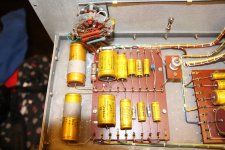 B&K1607_0001.JPG957.7 KB · Views: 99
B&K1607_0001.JPG957.7 KB · Views: 99 -
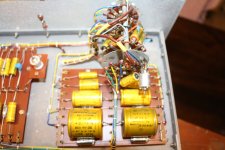 B&K1607_0002.JPG790.8 KB · Views: 99
B&K1607_0002.JPG790.8 KB · Views: 99 -
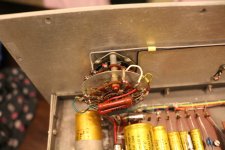 B&K1607_0003.JPG874.1 KB · Views: 91
B&K1607_0003.JPG874.1 KB · Views: 91 -
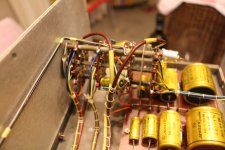 B&K1607_0004.JPG880.6 KB · Views: 88
B&K1607_0004.JPG880.6 KB · Views: 88 -
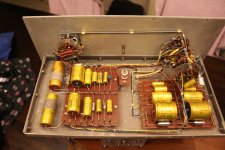 B&K1607_0005.JPG901.5 KB · Views: 85
B&K1607_0005.JPG901.5 KB · Views: 85 -
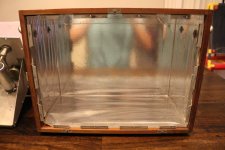 B&K1607_0006.JPG891.5 KB · Views: 68
B&K1607_0006.JPG891.5 KB · Views: 68 -
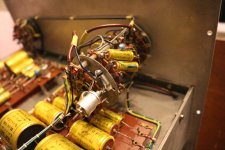 B&K1607_0007.JPG929.8 KB · Views: 61
B&K1607_0007.JPG929.8 KB · Views: 61 -
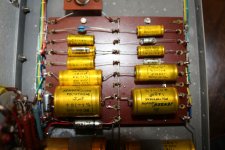 B&K1607_0008.JPG791.1 KB · Views: 56
B&K1607_0008.JPG791.1 KB · Views: 56 -
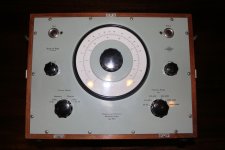 B&K1607_0009.JPG651.1 KB · Views: 67
B&K1607_0009.JPG651.1 KB · Views: 67
If you are in a rush the recessed socket is compatible with a banana pin.
The wood case is a nice touch.
Thanks, I didn't know that (my first B&K unit...
I works  . Just tested a noth at 1 khz, and could get a noth of over 80 db with carefull finetuning. This is directly connected to the EMU1212, so I would expect the input impedance of only 10K (the manual of the 1607 suggest minimum 100K) might be influencing this result a little.
. Just tested a noth at 1 khz, and could get a noth of over 80 db with carefull finetuning. This is directly connected to the EMU1212, so I would expect the input impedance of only 10K (the manual of the 1607 suggest minimum 100K) might be influencing this result a little.
The indicator is off a little, when the null is the deepest, instead of being right on the "100" mark, it is more on the "32" mark above (around 1020 Hz)
The indicator is off a little, when the null is the deepest, instead of being right on the "100" mark, it is more on the "32" mark above (around 1020 Hz)
@_Wim_ -- the low input Z of the EMU can affect the notch tuning, so buffer the output of the 1607 with a unity-gain quiet op-amp before you start trying to adjust anything. Also check the end points of the scale for any offsets -- if the frequency error is pretty constant and in the same direction, then it's just a matter of repositioning the dial/pointer
@ Wim - That looks pretty sweet. Nice looking innards nice wood case.
Maybe only the EU units had the wood case and export models didn't
have them to save on shipping.
The Jensen's are nice.
@ richEEM - I didn't think of checking the other frequencies
when I was adjusting my pointer. I dialed mine to as close
to 1000 Hz as I could hold it to.
@ Everyman, if you do go to adjust your pointer, be careful when
you loosen the two set screws. Measure the clearance between bottom
of pointer and the dial face. Even a small change closer to the dial face
might cause interference with dial face mounting screws. I used Popsicle
sticks to ensure clearance. Wooden tongue depressors from the pharmacy/apoteke/doctor's office would work.
Maybe only the EU units had the wood case and export models didn't
have them to save on shipping.
The Jensen's are nice.
@ richEEM - I didn't think of checking the other frequencies
when I was adjusting my pointer. I dialed mine to as close
to 1000 Hz as I could hold it to.
@ Everyman, if you do go to adjust your pointer, be careful when
you loosen the two set screws. Measure the clearance between bottom
of pointer and the dial face. Even a small change closer to the dial face
might cause interference with dial face mounting screws. I used Popsicle
sticks to ensure clearance. Wooden tongue depressors from the pharmacy/apoteke/doctor's office would work.
@_Wim_ -- the low input Z of the EMU can affect the notch tuning, so buffer the output of the 1607 with a unity-gain quiet op-amp before you start trying to adjust anything. Also check the end points of the scale for any offsets -- if the frequency error is pretty constant and in the same direction, then it's just a matter of repositioning the dial/pointer
Hello Richiem,
It is not my intention to adjust anything, just checking the unit out. As I can always finetune the adjustments in loopback (before I connect the DUT), I do not really see the point in messing with the unit (the finetuning will always be necesarry anyhow)
Instead of building a unity gain buffer, I was considering buiding a 40 db gain block. This way I could set the noth at 40db, and still use the max input voltage of my sound card, allowing me to see 40db deeper into the harmonics (in a noise free theoretical world off course...)
That may be an issue. I have used it with my Emu 1616m but used the instrument input that is 1MegOhm. I ran into a noise limit issue. Its very good but it still is limited in its noise floor. The oscillator I was testing did not have enough output to get above that limit.
I use the 1212, and this doesn't have an instrument input unfortunately.
Depending on the version you can get a 1616m or an 1820m that will work with it and isolate from the PC. The older version with Firewire connectors works with the 1820m. The boxes pop up on ebay pretty cheap occasionally. They are all getting older. They still have the best ADCs on the market.
This has been usef for me since I can leave the computer across the room and have the interface box on the workbench.
This has been usef for me since I can leave the computer across the room and have the interface box on the workbench.
Depending on the version you can get a 1616m or an 1820m that will work with it and isolate from the PC. The older version with Firewire connectors works with the 1820m. The boxes pop up on ebay pretty cheap occasionally. They are all getting older. They still have the best ADCs on the market.
This has been usef for me since I can leave the computer across the room and have the interface box on the workbench.
I have a 1212M Pcie card, no firewire connector on my card. Emu site tells me I need to look for the 1616m box (called the microdock m), do I need to check anything else before I start Ebaying?
Simple:
1) make sure its the M version
2) preferably not been screwed with. They are fragile. I have fried 2 by not being careful enough working on them. And the tweaks I tried ultimately made no improvement.
3) They seems to change hands here for $100 to $150.
Since you have experience with Patchmix using the microdock will be no real surprise, except for more I/O.
1) make sure its the M version
2) preferably not been screwed with. They are fragile. I have fried 2 by not being careful enough working on them. And the tweaks I tried ultimately made no improvement.
3) They seems to change hands here for $100 to $150.
Since you have experience with Patchmix using the microdock will be no real surprise, except for more I/O.
@ _Wim_ RE post-notch gain -- With my Active Twin-T, adding 20dB of post-notch gain lowers the noise by 3-4dB relative to the distortion products, which definitely helps to see them when they are near the noise floor. Demian used a 40dB post-notch gain, I think, but I don't remember how much, if any, he said that it helped.
- Status
- This old topic is closed. If you want to reopen this topic, contact a moderator using the "Report Post" button.
- Home
- Design & Build
- Equipment & Tools
- B&K 1607 notch filter activated